You are here: Home / Windows / How To Disable Fullscreen Optimizations In Windows 11/10
This article has been updated to be relevant for Windows 11 users.
The Fullscreen optimization feature in Windows 11 and 10 was introduced to make the gaming and video playing experience better for users.
When the Fullscreen Optimization feature is enabled, your PC prioritizes the CPU and GPU resources to enhance the games and playback videos.
But, this feature was soon reported to be responsible for FPS drops and other bugs.
Here, I have shown how to disable Fullscreen Optimization in Windows 10 and 11. So, keep reading.
Earlier, it was quite easy to disable the Fullscreen Optimization on Windows, as there was a dedicated option for it.
Later, the option was removed, and now Windows 10 and 11 use the Fullscreen Optimization feature by default. There is still a registry trick to disable it for all apps, which I have shown, but it’s not foolproof.
However, Windows allows users to disable Fullscreen optimation for individual apps. Here is how you can do it!
Turn Off Fullscreen Optimization For A Single Application
The option to disable Fullscreen Optimization for all apps may have been removed on Windows 10 and 11 by conventional means, but you can still disable it for individual apps. Here is how you can do it:
- Right-click on the app or game that you want to start without Fullscreen Optimization.
- Click on the Properties option from the right-click context menu.
- Select the Compatibility option.
- In the Settings section, check the Disable fullscreen optimizations option.
- Click on Apply and OK to save the changes.
Now the application will start without using the Fullscreen Optimizations feature.
This will be the case every time you open this app in that particular user account until you uncheck the Disable fullscreen optimization box from properties.
However, this won’t be the case for all the user accounts on your PC. To disable the Fullscreen Optimization for a particular app or game in all the user accounts in your PC, follow the steps given below:
- Open the Compatibility tab in the Properties of the app or game as mentioned above.
- Click on the Change settings for all users option.
- Check the Disable fullscreen optimizations option.
- Click on Apply and OK to save the changes.
Turn Off Fullscreen Optimization From Registry
To disable it for all apps in the latest Windows 10 version and Windows 11, you must make some changes in the Registry.
Windows Registry is the place where all the Windows settings are stored. When you make a Registry change, you need to be extra careful as even a small mistake can lead to a complete system crash.
NOTE: Before following the steps given below, backup the Registry keys or create a system restore point. This will allow you to restore any mistakes you make in the Registry.
Now, to disable Fullscreen Optimization from Registry, follow the steps given below:
- Press the Windows + R keys to open the Run utility.
- Type regedit and press Enter to open the Registry Editor.
- Navigate to the following registry key:
HKEY_CURRENT_USER\System\GameConfigStore - On the right panel, right-click on the empty white area and select New >> DWORD (32-bit) Value. This will create a new DWORD.
- Name the new DWORD GameDVR_DSEBehavior and double-click on it.
- Set 2 as the value to disable Fullscreen Optimization. Click on OK to save the changes.
If you want to enable Fullscreen Optimization again, then simply change the value to 0 from 2. - Finally, close the Registry Editor and restart the computer.
After the computer starts, Fullscreen Optimization will be disabled.
Turn Off Fullscreen Optimization From Settings (For Users With Older Windows 10 Versions)
The following methods no longer work for the latest versions of Windows 10 and 11. But if you are using an older version of Windows 10, then you can still use it.
Here is how you can do it:
- Right-click on the Start menu and select the Settings option. This will open the Settings app on your screen.
- In the Settings app, click on the System option.
- Next, click on the Display option.
- Scroll down and select the Advanced Graphics settings option.
- Now, uncheck the Enable Fullscreen Optimization box in the Fullscreen Optimization section.
If this option is unavailable on your PC, then try the next two methods.
Wrapping Up
So, there you have it. Now you know how to disable Fullscreen Optimizations in Windows 10 and 11.
Remember to backup your Registry or create a system restore point before editing the Registry keys.
If you have any other questions regarding this article, ask them in the comment section below.
Последние версии Windows 10 включают в себя новую функцию для геймеров. Она называется «Режим Полноэкранной Оптимизации». Если функция включена, она позволяет операционной системе оптимизировать производительность игр и приложений, когда они находятся в полноэкранном режиме. Однако некоторые пользователи заметили, что данная оптимизация может не работать должным образом и не повышает производительность приложений, как ожидалось. Если вы получаете побочные эффекты, такие как понижение производительности для отдельных игр с включенной функцией, вы можете попытаться отключить ее.
По умолчанию функция полноэкранной оптимизаций включена и доступна начиная с Windows build 17093.
Как вы уже знаете, Windows 10 имеет специальную функцию игрового режима, которая создана специально для геймеров. Функция повышает производительность и приоритет игр. Она уделяет приоритетное внимание ресурсам ЦП и графики (GPU), чтобы сделать игру более быстрой и плавной. Новая функция «Режим Полноэкранной Оптимизации» является частью оптимизации игр в Windows 10.
Если у вас есть проблемы с производительностью во время игр и функция «Режим Полноэкранной Оптимизации» включена, есть несколько способов отключить ее. Вы можете использовать «Параметры», настройку реестра, либо параметры совместимости для классических игр (не из магазина). Давайте рассмотрим подробнее эти способы.
Чтобы отключить «Режим Полноэкранной Оптимизации» в Windows 10 , выполните следующие действия.
- Откройте приложение «Параметры», нажав на значок шестеренки в меню «Пуск» или сочетание клавиш Win + I.
- Перейдите в раздел «Система» → «Дисплей».
- Прокрутите страницу в низ, найдите и нажмите ссылку — «Дополнительные графические параметры».
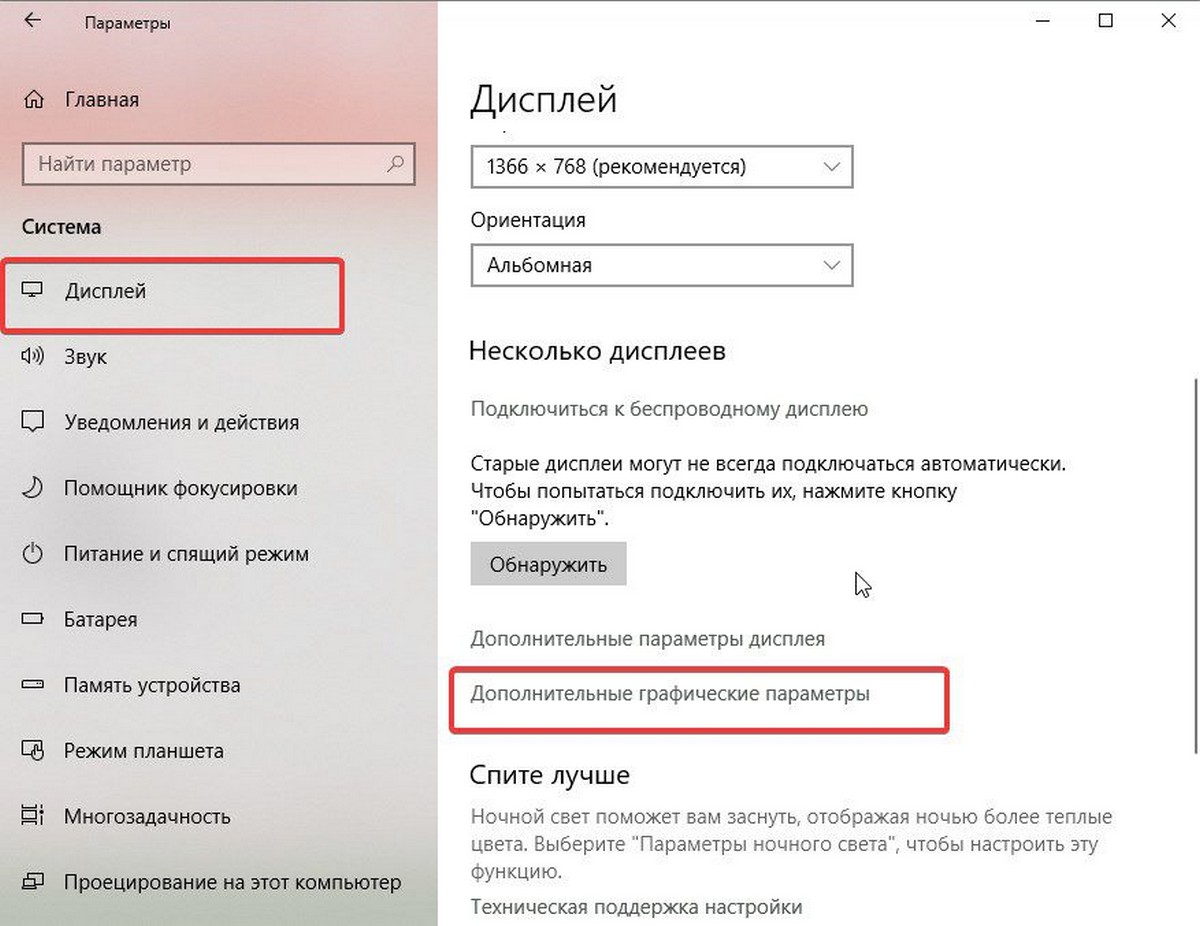
- На следующей странице отключите (снимите галочку) параметра «Включить оптимизацию в полноэкранном режиме».
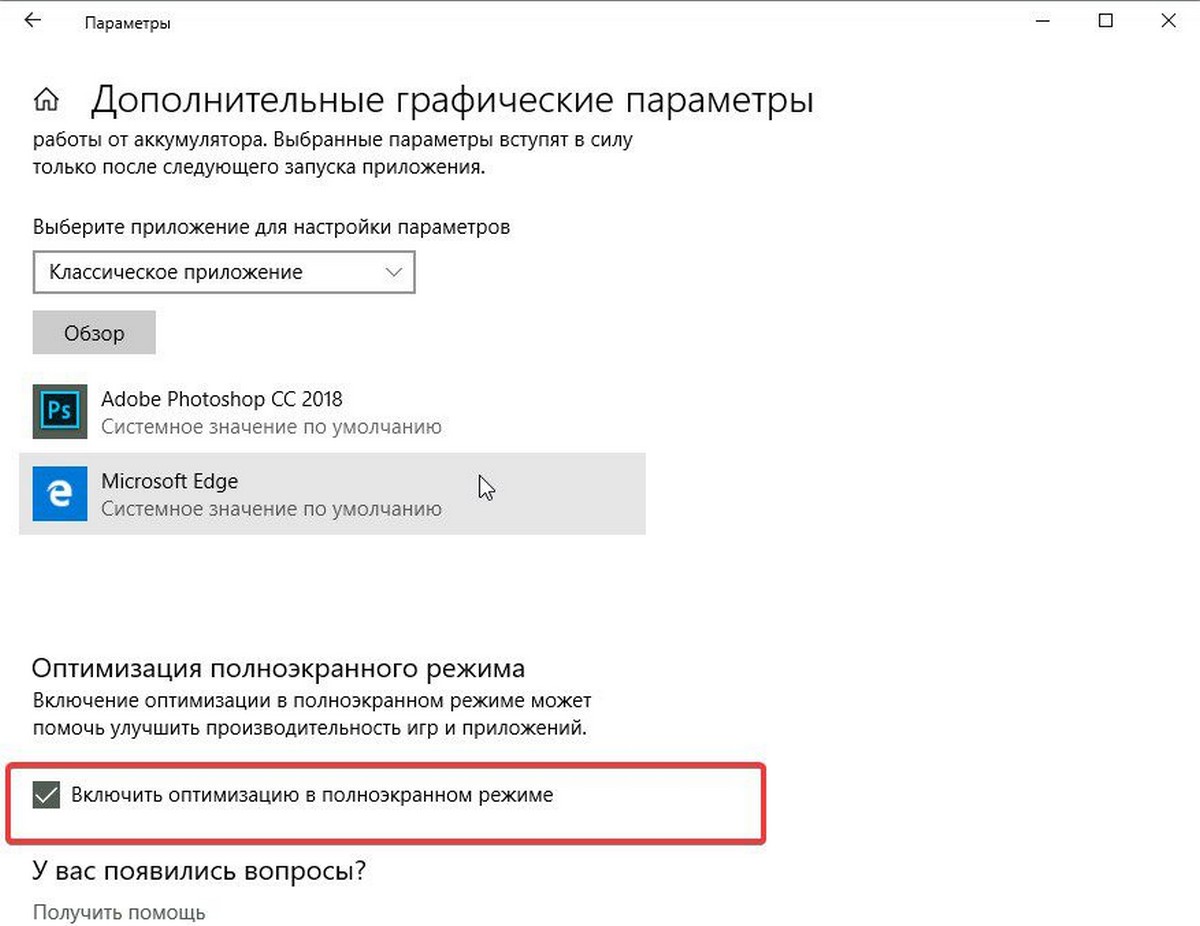
Все. Это изменение будет применяться ко всем приложениям, которые вы запускаете под учетной записью пользователя в Windows 10 на данном ПК.
Кроме того, этот параметр можно включить или отключить с помощью твика реестра.
Включить или отключить полноэкранный режим оптимизации с помощью настройки реестра.
- Откройте приложение «Редактор реестра».
- Перейдите к следующему разделу реестра.
HKEY_CURRENT_USER\System\GameConfigStore
- Справа измените или создайте новый параметр DWORD (32 бита) с именем — GameDVR_FSEBehavior.
Примечание. Даже если вы используете 64-битную Windows, вы все равно должны создать параметр DWORD (32 бита).
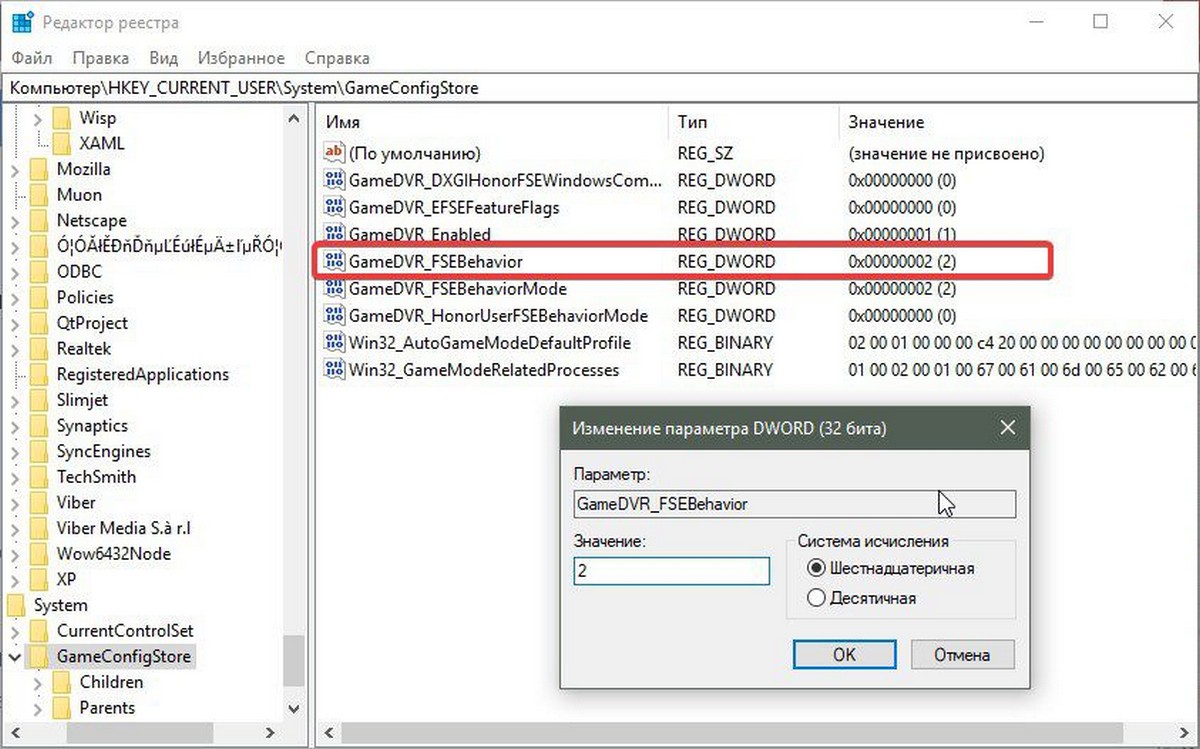
- Установите для параметра GameDVR_FSEBehavior значение равным 2, это позволит отключить его. Чтобы снова включить функцию, установите значение равным 0.
- Чтобы изменения, внесенные с помощью настройки реестра, вступили в силу, вам нужно выйти и войти в свою учетную запись пользователя.
Наконец, вы можете отключить функцию полноэкранного режима оптимизации для отдельных приложений. Это применимо к классическим играм, которые реализованы как настольные приложения.
Отключить полноэкранную оптимизацию для конкретного приложения.
- Кликните правой кнопкой мыши на исполняемый файл приложения или игры, для которой вы хотите отключить оптимизацию.
- В контекстном меню выберите «Свойства».
- Перейдите на вкладку «Совместимость».
- Включите параметр установив флажок для «Отключить оптимизацию во весь экран».

Это отключит полноэкранную оптимизацию для конкретного приложения для текущего пользователя.
Чтобы отключить оптимизацию для всех пользователей.
- Кликните правой кнопкой мыши на исполняемый файл приложения или игры, для которой вы хотите отключить оптимизацию.
- В контекстном меню выберите «Свойства».
- Перейдите на вкладку «Совместимость».
- Нажмите кнопку «Изменить параметры для всех пользователей».
…Кнопка «Изменение параметров для всех пользователей Windows 10»

- И задействуйте параметр «Отключить полноэкранный режим».
Вот и все.
Recent Windows 10 builds include a new feature for gamers. It is called «fullscreen optimizations». When enabled, it allows the operating system to optimize performance of games and apps when they are running in full screen mode. However, some users have noticed that this optimization might not work properly and doesn’t improve performance app performance as expected. If you are getting side effects like performance hits for your games with this feature enabled, you can try to disable it.
The Fullscreen Optimizations feature is enabled by default. It is available starting with Windows build 17093.
As you may already know, Windows 10 comes with a special Game Mode feature which is made especially for gamers. When enabled, it boosts the performance and priority of games. It prioritizes CPU and graphics (GPU) resources to make the game run faster and smoother. The new Fullscreen Optimizations feature is part of the game optimizations in Windows 10.
If you have issues with gaming performance with the Fullscreen Optimizations feature enabled, there are several ways to disable it. You can use either Settings, a Registry tweak, or compatibility options for classic (non-Store) games. Let’s review these methods.
To disable Fullscreen Optimizations in Windows 10, do the following.
- Open Settings.
- Go to System — Display.
- On the right, to the Advanced graphics settings link(«Graphics settings»).
- On the next page, turn off (uncheck) the option Enable fullscreen optimizations.
You are done. The change will be applied for all apps you use under your user account in Windows 10 on the current device.
Alternatively, this option can be enabled or disabled with a Registry Tweak.
Enable or Disable Fullscreen Optiminizations with a Registry tweak
- Open the Registry Editor app.
- Go to the following Registry key.
HKEY_CURRENT_USER\System\GameConfigStore
See how to go to a Registry key with one click.
- On the right, modify or create a new 32-Bit DWORD value GameDVR_FSEBehavior.
Note: Even if you are running 64-bit Windows you must still create a 32-bit DWORD value.
A value data of 0 will enable the feature. Set the GameDVR_FSEBehavior value to 2 to disable it. - To make the changes done by the Registry tweak take effect, you need to sign out and sign in to your user account.
Finally, you can disable the Fullscreen Optimizations feature for individual apps. It is applicable to classic games which are implemented as Desktop apps.
Disable Fullscreen Optimizations for Specific Apps
- Right-click the executable the for the app you want to disable Fullscreen Optimizations for.
- In the context menu, select Properties.
- Go to the Compatibility tab.
- Enable the option Disable fullscreen optimizations.
This will disable fullscreen optimizations for the specific app for the current user only. It is possible to disable them for all users. Here is how.
Disable Fullscreen Optimizations for all users
- Right-click the executable the for the app you want to disable Fullscreen Optimizations for.
- In the context menu, select Properties.
- Go to the Compatibility tab.
- Click on the Change settings for all users button.
- Check (turn on) the Disable fullscreen optimizations option.
That’s it.
Support us
Winaero greatly relies on your support. You can help the site keep bringing you interesting and useful content and software by using these options:
If you like this article, please share it using the buttons below. It won’t take a lot from you, but it will help us grow. Thanks for your support!
Windows 10 and Windows 11 include a feature known as “Fullscreen Optimizations,” which is designed to improve gaming performance by allowing the operating system to optimize the display for full-screen applications. However, in some instances, this feature can cause issues, such as input lag, stuttering or graphical glitches in games or other full-screen applications. If you’re experiencing these issues, you might consider disabling fullscreen optimizations.
This guide will take you through the detailed steps to disable fullscreen optimizations, discuss when and why you might want to disable this feature, and how it can affect the performance of your applications.
Understanding Fullscreen Optimizations
Fullscreen optimizations are a feature introduced in Windows 10 to enhance the performance of full-screen applications, primarily games. When an application enters fullscreen mode, Windows can optimize how it renders graphics and handles input by using techniques such as:
- Reducing Latency: The operating system can prioritize resources so that the application runs smoother with minimal lag.
- Directly Accessing Graphics Hardware: Fullscreen optimizations can enable applications to interact more directly with hardware, potentially improving performance.
- Dynamic Resolution Scaling: This allows applications to adjust automatically based on system performance.
While many users experience improved performance due to these optimizations, others report issues such as:
- Frame rate issues
- Lag or input delay
- Visual artifacts or stuttering
Disabling fullscreen optimizations can mitigate these issues for some users, particularly gamers or users of graphically intensive applications.
When to Disable Fullscreen Optimizations
You might consider disabling fullscreen optimizations if you encounter:
- Input Lag: If your game or application feels unresponsive or exhibits noticeable input delay.
- Stuttering or Low Frame Rates: If your frames drop unexpectedly, even at recommended settings.
- Graphical Glitches: If you experience screen tearing, flickering, or artifacts during gameplay or while using applications that require full-screen mode.
If you’re not experiencing these issues, it’s recommended to leave fullscreen optimizations enabled, as they might provide smoother operation and enhanced performance.
How to Disable Fullscreen Optimizations
The process to disable fullscreen optimizations can be accomplished through the properties of individual applications, whether they are games or other software requiring full-screen mode. Here’s how to do it step by step:
Method 1: Using Application Properties
-
Locate the Application:
- Find the executable (.exe) file of the application for which you want to disable fullscreen optimizations. This could be in the Start Menu, desktop, or within a program folder in File Explorer.
-
Open Properties:
- Right-click the executable file and select «Properties» from the context menu.
-
Navigate to the Compatibility Tab:
- In the Properties window, click on the «Compatibility» tab.
-
Disable Fullscreen Optimizations:
- Under the “Settings” section, check the box labeled “Disable fullscreen optimizations.”
-
Apply the Changes:
- Click «Apply,» then «OK» to save your changes.
-
Test the Application:
- Launch the application to see if disabling fullscreen optimizations resolves your issues.
Method 2: Using Windows Registry (Advanced Users)
If you want to disable fullscreen optimizations for multiple applications in one go, you can modify the Windows Registry. This method is recommended for advanced users who are comfortable working with the system registry.
Warning: Back up your registry before making changes, as incorrect modifications can lead to system instability.
-
Open Registry Editor:
- Press
Windows Key + Rto open the Run dialog. - Type
regeditand press Enter. If prompted by User Account Control, click «Yes.»
- Press
-
Navigate to the Application Registry Key:
- Use the left pane to navigate to the following path:
HKEY_CURRENT_USERSoftwareMicrosoftWindows NTCurrentVersionAppCompatFlagsLayers - If the ‘Layers’ key does not exist, you can create it by right-clicking on
AppCompatFlags, choosing «New,» and selecting «Key.»
- Use the left pane to navigate to the following path:
-
Add a New String Value:
- Right-click in the right pane and select «New» > «String Value.»
- Right-click the new string and choose «Rename.» Enter the full path of the application whose fullscreen optimizations you want to disable (e.g.,
C:Program FilesYourGameYourGame.exe).
-
Set the Value:
- Double-click the new string and set its value to
~ dxgi. This command tells Windows to disable fullscreen optimizations specifically for that application.
- Double-click the new string and set its value to
-
Close Registry Editor:
- Exit the Registry Editor.
-
Test the Application:
- Run the application to determine if the changes have resolved your issues.
Verifying the Changes
No matter which method you choose to disable fullscreen optimizations, it’s essential to verify that the changes have taken effect. Launch the application and observe whether you notice improvements regarding input lag, frame rates, or visual artifacts.
Try varying your settings and playing different games before deciding whether the changes have had a positive effect.
Troubleshooting Common Issues
While disabling fullscreen optimizations can help with certain issues, you may still encounter problems. Here are some common complications and how to address them:
Input Lag Persists
If you still notice input lag despite disabling fullscreen optimizations, consider:
- Checking Other Game Settings: Ensure that your graphics settings are appropriate for your hardware.
- Updating Drivers: Outdated graphics drivers can cause various performance issues. Go to your GPU manufacturer’s website to download the latest drivers.
- Lowering Graphic Settings: Experiment with lowering graphics settings within the game or application.
Graphical Issues
For graphical glitches, you may want to:
- V-Sync Settings: Enable or disable V-Sync (Vertical Synchronization) in your game settings.
- Resolution Scaling: Adjust your resolution settings to determine if that alleviates screen tearing or other artifacts.
Performance Issues Persist
If overall performance remains poor after disabling fullscreen optimizations:
-
Check Background Applications: Other applications consuming system resources might interfere with your game’s performance. Use the Task Manager (
Ctrl + Shift + Esc) to view resource usage and end unnecessary tasks. -
Run in Windowed Mode: As a temporary solution, running the game in windowed mode might improve performance.
Conclusion
Fullscreen optimizations can improve performance for various applications in Windows 10 and Windows 11, but not every user benefits from this feature. If you’re experiencing issues like input lag, stuttering, or graphical glitches, disabling fullscreen optimizations may provide a solution.
With the methods outlined in this guide, you can disable fullscreen optimizations for specific applications either through their properties or the Windows Registry. Always keep in mind that while disabling this feature can alleviate certain problems, it could also take away potential performance benefits in other scenarios.
Before making these adjustments, ensure that your system is updated and that you understand the implications of the changes you are making. If issues persist after disabling fullscreen optimizations, further troubleshooting might be necessary to identify and resolve the root cause of your performance issues in full-screen applications.
Download Windows Speedup Tool to fix errors and make PC run faster
Full-Screen Optimizations is a feature on Windows devices that help them function better. It is enabled by default for applications like video players and games. When this feature is enabled, the gaming or video playback experience is enhanced by prioritizing the CPU and GPU resources for that particular process. But sometimes, it results in a drop in the frame rate (FPS) when in full-screen mode. The solution to fix these frame drops would be to disable these full-screen optimizations. But unfortunately, Microsoft has removed this features for Windows 11/10 in the recent releases – but there is still a way you can get this done.
In this guide, we will cover the following ways:
- Using the Registry Editor.
- Applicable to a particular set of users.
- Applicable for all the users.
- Using Windows 10 Settings.
1] Using the Registry Editor
Hit the WINKEY + R button combination to launch the Run utility, type in regedit and hit Enter. Click on Yes for the UAC or User Account Control Prompt that you get.
Once Registry Editor opens, navigate to the following key location-
HKEY_CURRENT_USER\System\GameConfigStore
Now right click on Explorer. Select New > DWORD (32-bit) Value.
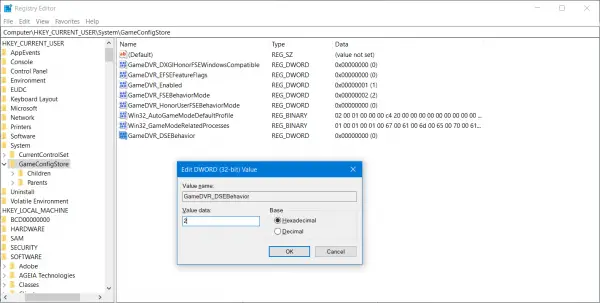
Name the newly created DWORD to GameDVR_DSEBehavior and hit Enter to save it.
Double click on the GameDVR_DSEBehavior DWORD and set its value to the following depending on your choice,
- 2: Disable Fullscreen optimizations.
- 0: Enable Fullscreen optimizations.
After you are done setting a value, close the Registry Editor and Reboot your computer for the changes to take effect.
2] Applicable to a particular set of users
Start by locating the main executable file of the application or game for which you need to enable or disable the fullscreen optimizations.
Right-click on the located executable file and click on Properties. Switch the tab labeled as Compatibility. Under the section labeled as Settings.
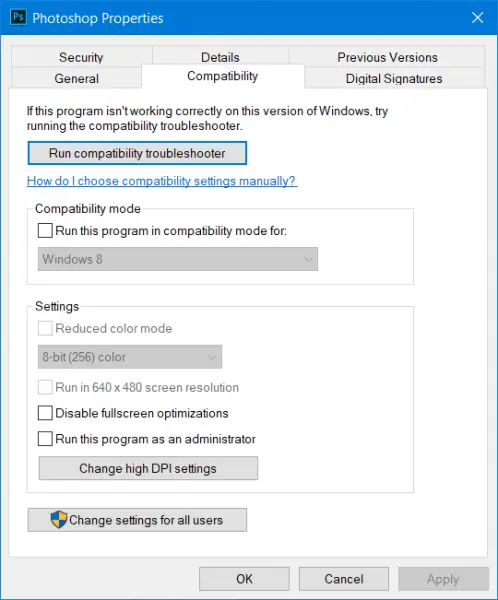
Check the option labeled as Disable fullscreen optimizations in order to disable the feature and vice versa for the opposite.
Click on Apply and then click on OK for the settings to be applied.
3] Applicable to all the users
Start by locating the main executable file of the application or game for which you need to enable or disable the fullscreen optimizations.
Right-click on the located executable file and click on Properties. Switch the tab labeled as Compatibility.
Click on the button labeled as Change settings for all users on the bottom part of the mini window.

Under the section labeled as Settings.
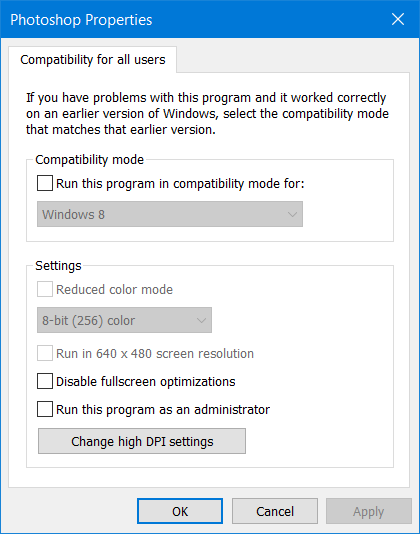
Check the option labeled as Disable fullscreen optimizations in order to disable the feature and vice versa for the opposite.
Click on Apply and then click on OK for the settings to be applied.
4] Using Windows Settings (Earlier Windows 10 releases only)
For earlier releases, you can follow this method. This method is not available for releases starting Windows 10 v1803.
Launch the Windows 10 Settings app. Now, navigate to System > Display. Scroll down a bit and click on the Graphics Settings link. This will open the Advanced Graphics settings page.
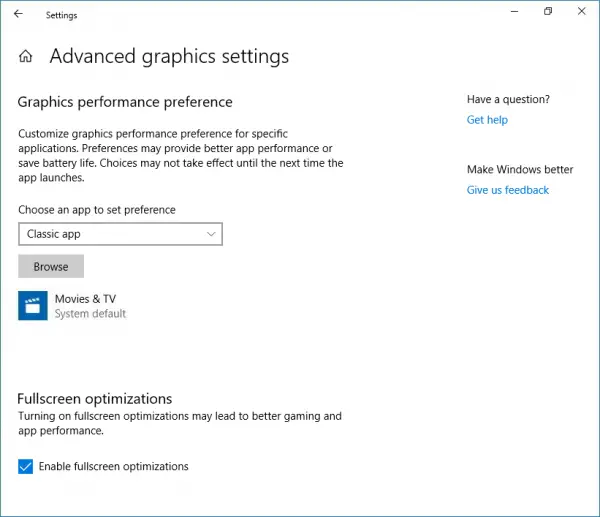
Under the section labeled as, Fullscreen optimizations, uncheck the option labeled as Enable Fullscreen optimizations to disable the feature.
Was that helpful?
Ayush has been a Windows enthusiast since the day he got his first PC with Windows 98SE. He is an active Windows Insider since Day 1 and has been a Windows Insider MVP.






